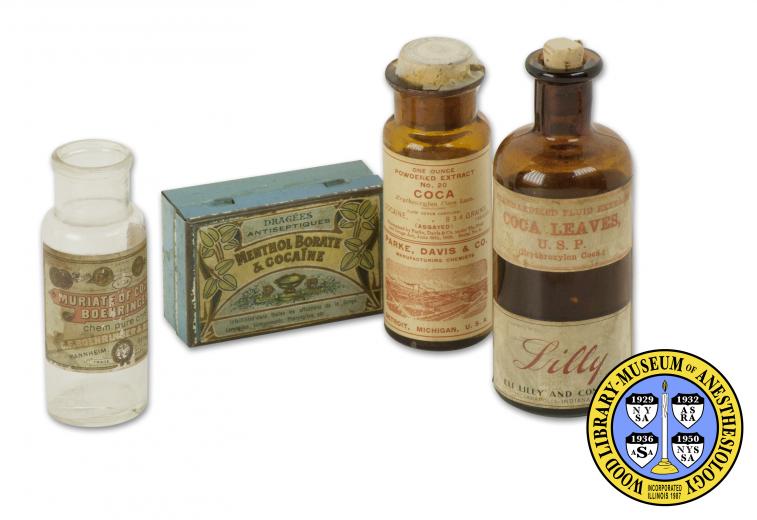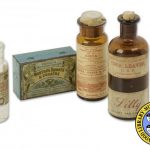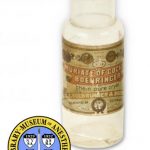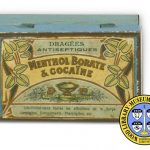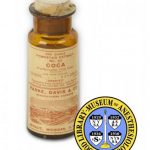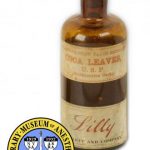Cocaine
Displayed from left to right is a bottle for Boehringer Muriate of Cocaine, a tin for menthol and cocaine throat lozenges, a bottle for powdered cocaine manufactured by Park, Davis & Co., and a glass bottle for fluid extract of cocaine manufactured by Eli Lilly and Co.
Cocaine was the first local anesthetic for regional anesthesia. Regional anesthesia involves numbing only part of the body by injecting local anesthetics into or near nerves, where they interrupt the transmission of pain signals to the brain. Cocaine is a derivative of a plant native to South America, Erythroxylon coca, or coca for short. The cultivation of the plant pre-dates the Incan civilization. Long before the arrival of European explorers, coca was used by indigenous peoples of South America as a remedy for a number of health conditions, including headaches.
In 1859, a German chemist, Albert Niemann (1834-1861) extracted the active substance from coca leaves and named it cocaine. However, it wasn't until 1884 that it became widely known as a local anesthetic. In that year Dr. Karl Koller (1857-1944), a German ophthalmologist, announced his successful use of cocaine as a topical anesthetic for eye surgery. In Europe and the United States there was an immediate surge of experimentation with cocaine, leading to revolutionary developments in regional anesthesia as well as new surgical procedures.
Catalog Record: Cocaine
Four Catalog Records (aiuz, aiuy, aiva, aivb):
Access Key: aiuz
Accession No.: 2007-03-09-1
Title: Muriate of cocaine Boehringer [bottle] / C.F. Boehringer & Soehne.
Corporate Author: C.F. Boehringer & Soehne.
Title variation: Alt Title
Title: Boehringer muriate of cocaine bottle.
Publisher: Mannheim, Germany : C.F. Boehringer & Soehne, [1885-1930].
Physical Description: 1 bottle ; glass : 9.5 x 3.5 dia. cm.
Subject: Cocaine.
Subject: Coca.
Subject: Drug Packaging.
Subject: Anesthetics, Local.
Subject: Central Nervous System Stimulants.
Note Type: General
Notes: Title from manufacturer’s marking plus a descriptive term.
Note Type: General
Notes: This container is empty of any original pharmaceuticals.
Note Type: Citation
Notes: Fink BR. Leaves and needles: the introduction of surgical local anesthesia.
Bull Anesth Hist. 2001;19(1):7-11.
Note Type: Citation
Notes: Petersen RC. History of cocaine. In: Petersen RC, Stillman RC, eds. Cocaine:
1977. Rockville, Md.: Dept. of Health, Education and Welfare, 1977:17-28.
Note Type: Citation
Notes: Raj PP. Historical aspects of regional anesthesia. In: Raj PP, ed. Textbook
of Regional Anesthesia. New York: Churchill Livingstone, 2002:7-13.
Note Type: Physical Description
Notes: 1 clear glass bottle; The neck of the bottle is approx 2 cm in height, and
the opening at the top is approx 2.5 cm in dia.; A paper label with green,
white, salmon, brown, and black colors is pasted to the bottle; Manufacturer
markings on the label include front and back images of three medals with the
word “PRIZE” between the left and middle medals, and “MEDALS” between the
middle and right medals; From left to right marked above the medals is,
“LONDON 1862”, “PARIS 1867”, and “VIENNA 1873”; Marked below the images of
the medals from top to bottom is, “1 oz. [NEW LINE] MURIATE OF COCAINE [new
line] BOEHRINGER [new line] chem pure cryst. [new line] C.F. BOEHRINGER &
SOEHNE [new line] MANNHEIM [new line] TRADE [the Boehringer logo] MARK”.
Note Type: Reproduction
Notes: Photographed by Mr. William Lyle, July 28, 2010; Photographed with 2 coca
extract or cocaine bottles and a lozenge tin (SydneyPlus Records: aiuy, aiva,
aivb).
Note Type: Historical
Notes: Cocaine is a derivative of a plant native to South America, Erythroxylum coca
or coca for short. The cultivation of coca and the chewing of its leaves
pre-date the Incan civilization. Long before the first European explorers
arrived in South American, coca was used by indigenous peoples of South
America as a remedy for a diverse number of health conditions including
headaches and stomach disorders. They also chewed coca leaves to benefit from
the pleasant feeling and energy boost it provided, as well as for the control
of hunger. It may also have been used as a topical analgesic or anesthetic
(Petersen, 1977). Some scholars believe that early South Americans may have
used coca topically for surgical procedures, such as trephination.
Note Type: Historical
Notes: In 1859 a German chemist, Albert Niemann (1834-1861), extracted an active
substance from coca leaves and named it cocaine. (Fink, 2001). The effects of
purified cocaine are significantly more potent than the effects experienced
from chewing coca leaves. Western scientists and physicians were not able to
fully exploit the coca plant until late 1800s, possibly due to the lack of a
reliable source of coca leaves; Coca plants and the leaves quickly
deteriorated over long journeys from South America. Although others had
noted numbness caused by cocaine and even suggested it might be used as a
local anesthetic, Karl Koller (1857-1944) was the first Westerner to test and
use it as a topical anesthetic for a surgical procedure in 1884 (Fink, 2001).
News of Koller’s success spread rapidly throughout Europe and the United
States, igniting an explosion of experimentation that led to revolutionary
developments in regional anesthesia (Raj, 2002). It was not long before the
disadvantages (including addiction, and adverse effects such as high blood
pressure and heart arrhythmias) of cocaine were recognized and the search for
a better local anesthetic began.
Note Type: Historical
Notes: The late 19th and early 20th centuries saw the production of a wide variety
of commercial cocaine products, such as medicines, lozenges, tonics and
drinks. These products were heavily marketed to cure a plethora of ailments,
including asthma, colds, alcoholism, opiate addiction, eczema, headache and
melancholy (Petersen, 1977). One very popular drink, a wine called Vin
Mariani, was endorsed by popular actors, writers, artists, physicians, and
even Popes. A drink familiar to today’s consumers, Coca Cola, was another
early cocaine containing product marketed as a “ … Brain tonic and cure for
all nervous affections … “ (Petersen, 1973).
Access Key: aiuy
Accession No.: 2004-04-20-1
Title: Menthol borate & cocaïne dragées antiseptiques [tin] / [made by] D & P.
Corporate Author: D & P.
Title variation: Alt Title
Title: Dragées antiseptiques menthol borate & cocaïne.
Title variation: Alt Title
Title: Tin for menthol borate and cocaine throat lozenges.
Publisher: [S.l.] : D & P, [1880-1912].
Physical Description: 1 tin : metal ; 3 x 8 x 5 cm.
Subject: Cocaine.
Subject: Drug Packaging.
Subject: Anesthetics, Local.
Subject: Analgesics.
Note Type: General
Notes: Title from manufacturer’s marking plus a descriptive term.
Note Type: General
Notes: This container is empty of any original pharmaceuticals.
Note Type: Citation
Notes: Fink BR. Leaves and needles: the introduction of surgical local anesthesia.
Bull Anesth Hist. 2001;19(1):7-11.
Note Type: Citation
Notes: Petersen RC. History of cocaine. In: Petersen RC, Stillman RC, eds. Cocaine:
1977. Rockville, Md.: Dept. of Health, Education and Welfare, 1977:17-28.
Note Type: Citation
Notes: Raj PP. Historical aspects of regional anesthesia. In: Raj PP, ed. Textbook
of Regional Anesthesia. New York: Churchill Livingstone, 2002:7-13.
Note Type: Physical Description
Notes: Rectangular tin with hinged lid; On the top of the lid is a manufacture’s
label with blue, yellow, green and brown colors; From the top of the label to
the bottom, markings include, “DRAGÉES [new line] ANTISEPTIQUES”, in large
lettering, “MENTHOL BORATE & COCAINE”, the logo for D & P with the text
“MARQUE DEPOSEE”, and the claim in small lettering, “Infaillibles dans toutes
les affections de la Gorge, Laryngites, Enrouements, Pharyngites, etc.”; The
tin is pained a blue and yellow gold color on its sides; On the bottom is
another label with manufacturer’s markings, “AFFECTIONS DE LA GORGE [new
line] Soulagement immédiat [new line] PAR LES [new line] PRODUITS
ANESTHESIQUES ANTISEPTIQUES [new line] AU MENTHOL”, the D & P logo, and
“exiger la marque”; Paint with chips, scratches, and the tin is slightly
rusted.
Note Type: Reproduction
Notes: Photographed by Mr. William Lyle, July 28, 2010; Photographed with 3 coca
extract or cocaine bottles (SydneyPlus Records: aiuz, aiva, aivb).
Note Type: Historical
Notes: Cocaine is a derivative of a plant native to South America, Erythroxylum coca
or coca for short. The cultivation of coca and the chewing of its leaves
pre-date the Incan civilization. Long before the first European explorers
arrived in South American, coca was used by indigenous peoples of South
America as a remedy for a diverse number of health conditions including
headaches and stomach disorders. They also chewed coca leaves to benefit from
the pleasant feeling and energy boost it provided, as well as for the control
of hunger. It may also have been used as a topical analgesic or anesthetic
(Petersen, 1977). Some scholars believe that early South Americans may have
used coca topically for surgical procedures, such as trephination.
Note Type: Historical
Notes: In 1859 a German chemist, Albert Niemann (1834-1861), extracted an active
substance from coca leaves and named it cocaine. (Fink, 2001). The effects of
purified cocaine are significantly more potent than the effects experienced
from chewing coca leaves. Western scientists and physicians were not able to
fully exploit the coca plant until late 1800s, possibly due to the lack of a
reliable source of coca leaves; Coca plants and the leaves quickly
deteriorated over long journeys from South America. Although others had
noted numbness caused by cocaine and even suggested it might be used as a
local anesthetic, Karl Koller (1857-1944) was the first Westerner to test and
use it as a topical anesthetic for a surgical procedure in 1884 (Fink, 2001).
News of Koller’s success spread rapidly throughout Europe and the United
States, igniting an explosion of experimentation that led to revolutionary
developments in regional anesthesia (Raj, 2002). It was not long before the
disadvantages (including addiction, and adverse effects such as high blood
pressure and heart arrhythmias) of cocaine were recognized and the search for
a better local anesthetic began.
Note Type: Historical
Notes: The cocaine in these menthol borate and cocaine throat lozenges may have
provided some topical anesthesia or analgesia for a sore throat. The late
19th and early 20th centuries saw the production of a wide variety of
commercial cocaine products, such as medicines, lozenges, tonics and drinks.
These products were heavily marketed to cure a plethora of ailments,
including asthma, colds, alcoholism, opiate addiction, eczema, headache and
melancholy (Petersen, 1977). One very popular drink, a wine called Vin
Mariani, was endorsed by popular actors, writers, artists, physicians, and
even Popes. A drink familiar to today’s consumers, Coca Cola, was another
early cocaine containing product marketed as a “ … Brain tonic and cure for
all nervous affections … “ (Petersen, 1973).
Access Key: aiva
Accession No.: 2004-12-12-1 A
Title: Coca : powdered extract no. 20 : Erythroxylon coca lam. [bottle] / Parke, Davis & Co.
Title variation: Alt Title
Title: Powdered extract no. 20 : coca : Erythroxylon coca lam.
Title variation: Alt Title
Title: Park, Davis & Co. bottle for powdered cocaine.
Publisher: Detroit, Mich. : Park, Davis & Co., [1906-1930].
Physical Description: 1 bottle ; glass, cork ; 11 x 4 dia. cm.
Subject: Cocaine.
Subject: Drug Packaging.
Subject: Anesthetics, Local.
Subject: Coca.
Subject: Central Nervous System Stimulants.
Note Type: General
Notes: Title from manufacturer’s markings plus a descriptive term.
Note Type: General
Notes: This container is empty of any original pharmaceuticals.
Note Type: Citation
Notes: Fink BR. Leaves and needles: the introduction of surgical local anesthesia.
Bull Anesth Hist. 2001;19(1):7-11.
Note Type: Citation
Notes: Petersen RC. History of cocaine. In: Petersen RC, Stillman RC, eds. Cocaine:
1977. Rockville, Md.: Dept. of Health, Education and Welfare, 1977:17-28.
Note Type: Citation
Notes: Raj PP. Historical aspects of regional anesthesia. In: Raj PP, ed. Textbook
of Regional Anesthesia. New York: Churchill Livingstone, 2002:7-13.
Note Type: Physical Description
Notes: Bottle of amber glass with a cork stopper; The cork stopper measures 2.5 cm
in dia.; Marked on top of the stopper is the Parke Davis logo and the text,
“PARKE, DAVIS, & CO., DETROIT, MICH. U.S.A.”; Two white paper labels with red
print are pasted to the bottle; Markings on the front label, from top to
bottom, include, “ONE OUNCE [new line] POWDERED EXTRACT [new line] No. 20
[new line] COCA [new line] Erythroxylon Coca Lam. [new line] EACH OUNCE
CONTAINS: [new line] COCAINE – – 8 3-4 GRAINS. [new line] (ASSAYED) [new
line] Guaranteed by Park, Davis & Co. under The Food [new line] and Drugs Act
June 30th, 1906. Serial No. 6. [new line] PARKE, DAVIS & CO. [new line]
MANUFACTURING CHEMISTS [image of a Park Davis plant] DETROIT, MICHIGAN, U.S.A
“; Markings on the back label, from top to bottom, include, “Keep the bottle
securely corked in a cool, dry place. [new line] POWERED EXTRACT [new line]
COCA [new line] (ASSAYED) 1464089 [new line] Erythroxylon Coca Lam. [NEW
LINE] STANDARD-Of the same strength as the assayed solid extract, containing
2 percent ether-soluble alkaloid (cocaine) [new line] One grain represents
four grains of standard Coca. [new line] Stimulant and tonic. Coca sustains
the system in an extraordinary manner under fatigue. [new line] Dose-10 to 25
grains (0.65 to 1.6 Gm.)
Note Type: Reproduction
Notes: Photographed by Mr. William Lyle, July 28, 2010; Photographed with 2 coca
extract or cocaine bottles and a lozenge tin (SydneyPlus Records: aiuy, aiuz,
aivb).
Note Type: Historical
Notes: Cocaine is a derivative of a plant native to South America, Erythroxylum coca
or coca for short. The cultivation of coca and the chewing of its leaves
pre-date the Incan civilization. Long before the first European explorers
arrived in South American, coca was used by indigenous peoples of South
America as a remedy for a diverse number of health conditions including
headaches and stomach disorders. They also chewed coca leaves to benefit from
the pleasant feeling and energy boost it provided, as well as for the control
of hunger. It may also have been used as a topical analgesic or anesthetic
(Petersen, 1977). Some scholars believe that early South Americans may have
used coca topically for surgical procedures, such as trephination.
Note Type: Historical
Notes: In 1859 a German chemist, Albert Niemann (1834-1861), extracted an active
substance from coca leaves and named it cocaine. (Fink, 2001). The effects of
purified cocaine are significantly more potent than the effects experienced
from chewing coca leaves. Western scientists and physicians were not able to
fully exploit the coca plant until late 1800s, possibly due to the lack of a
reliable source of coca leaves; Coca plants and the leaves quickly
deteriorated over long journeys from South America. Although others had
noted numbness caused by cocaine and even suggested it might be used as a
local anesthetic, Karl Koller (1857-1944) was the first Westerner to test and
use it as a topical anesthetic for a surgical procedure in 1884 (Fink, 2001).
News of Koller’s success spread rapidly throughout Europe and the United
States, igniting an explosion of experimentation that led to revolutionary
developments in regional anesthesia (Raj, 2002). It was not long before the
disadvantages (including addiction, and adverse effects such as high blood
pressure and heart arrhythmias) of cocaine were recognized and the search for
a better local anesthetic began.
Note Type: Historical
Notes: The late 19th and early 20th centuries saw the production of a wide variety
of commercial cocaine products, such as medicines, lozenges, tonics and
drinks. These products were heavily marketed to cure a plethora of ailments,
including asthma, colds, alcoholism, opiate addiction, eczema, headache and
melancholy (Petersen, 1977). One very popular drink, a wine called Vin
Mariani, was endorsed by popular actors, writers, artists, physicians, and
even Popes. A drink familiar to today’s consumers, Coca Cola, was another
early cocaine containing product marketed as a “ … Brain tonic and cure for
all nervous affections … “ (Petersen, 1973).
Access Key: aivb
Accession No.: 1999-04-27-1 G
Title: Standardized fluid extract coca leaves, U.S.P. (Erythroxylon coca) [bottle] / Eli Lilly and Company.
Corporate Author: Eli Lilly and Company.
Title variation: Alt Title
Title: Lilly standardized coca fluid extract bottle.
Publisher: Indianapolis, Ind. : Eli Lilly and Company, [1905-1930].
Physical Description: 1 bottle : glass, cork ; 13.5 x 5 dia. cm.
Subject: Cocaine.
Subject: Coca.
Subject: Drug Packaging.
Subject: Anesthetics, Local.
Subject: Central Nervous System Stimulants.
Note Type: General
Notes: Title from manufacturer’s markings plus a descriptive term.
Note Type: General
Notes: This container is empty of any original pharmaceuticals.
Note Type: Citation
Notes: Fink BR. Leaves and needles: the introduction of surgical local anesthesia.
Bull Anesth Hist. 2001;19(1):7-11.
Note Type: Citation
Notes: Petersen RC. History of cocaine. In: Petersen RC, Stillman RC, eds. Cocaine:
1977. Rockville, Md.: Dept. of Health, Education and Welfare, 1977:17-28.
Note Type: Citation
Notes: Raj PP. Historical aspects of regional anesthesia. In: Raj PP, ed. Textbook
of Regional Anesthesia. New York: Churchill Livingstone, 2002:7-13.
Note Type: Physical Description
Notes: Amber glass bottle with a cork stopper; The neck of the bottle measures
approx 3 cm in height; The opening is approx 1.5 cm in dia.; Two paper labels
are pasted to the front of the bottle; Manufacturer markings on the upper
front label include, “STANDARDIZED FLUID EXTRACT [new line] COCA LEAVES, [new
line] U.S.P. [new line] (Erythroxylon coca.)”; Markings on the lower label
include, ” Lilly [new line] ELI LILLY AND COMPANY. [new line] INDIANAPOLIS,
INDIANA, U.S.A.”; Markings on the paper label pasted to the back of the
bottle include, “FL. EXT. COCA LEAVES U.S.P. [new line] Erythroxylon Coca Lam
or Erythroxylon Truxillense, Rushy. [new line] Nat. Ord. Erythroxylacae [new
line] Synonyms – Huanuco coca and Truxllio coca. – Coca, U. S. P. [new line]
Range – Peru, Bolivia, cultivated in Ceylon, Java and British India. [new
line] Habitat – On mountain slopes to an altitude of 8000 feet. [new line]
Part used – The dried leaves. [new line] Standard of Strength – 0.5 per cent
ether soluble alkaloids. [new line] Action and uses – Poisonous. Anodyne
and antispasmodic. It is a powerful nervous stimulant and increases the
power of the muscular system to sustain fatigue. It contributes to mental
cheerfulness and has been used in the treatment of opium habit, in which,
however, it has no value except to antagonize certain heart symptoms. It
should, in such cases, never be used as a regular remedy. [new line]
Antidotes – Alcohol and opium as stimulants to the heart, artificial
respiration. Chloral is the most direct antagonist. [new line] Preparations.
6582-224029 [new line] Tincture Coco Leaves – Fl. ext. Coca leaves. Lilly, 1
5/8 fl. ozs. Diluted alcohol 14 3/8 fl. ozs.; Mix – Dose 1 to 4 fl. drs. [new
line] Wine Coca, U.S.P. – Fl. ext Coca leaves, Lilly, 1 fl. oz.; alcohol ,1
1/4 fl. ozs. ; sugar, 1 troy ounce; red wine q.s. to make 16 fl. ozs.; Mix,
allow to stand two days, and filter. Dose – 1/4 to 1 fl. oz. [new line] ELI
LILLY & COMPANY LABEL REVISED, 1905.”; Marked in the glass in the bottom of
the bottle is, “2I [new line] EL & CO”.
Note Type: Reproduction
Notes: Photographed by Mr. William Lyle, July 28, 2010; Photographed with 2 coca
extract or cocaine bottles and a lozenge tin (SydneyPlus Records: aiuy, aiuz,
aiva).
Note Type: Historical
Notes: Cocaine is a derivative of a plant native to South America, Erythroxylum coca
or coca for short. The cultivation of coca and the chewing of its leaves
pre-date the Incan civilization. Long before the first European explorers
arrived in South American, coca was used by indigenous peoples of South
America as a remedy for a diverse number of health conditions including
headaches and stomach disorders. They also chewed coca leaves to benefit from
the pleasant feeling and energy boost it provided, as well as for the control
of hunger. It may also have been used as a topical analgesic or anesthetic
(Petersen, 1977). Some scholars believe that early South Americans may have
used coca topically for surgical procedures, such as trephination.
Note Type: Historical
Notes: In 1859 a German chemist, Albert Niemann (1834-1861), extracted an active
substance from coca leaves and named it cocaine. (Fink, 2001). The effects of
purified cocaine are significantly more potent than the effects experienced
from chewing coca leaves. Western scientists and physicians were not able to
fully exploit the coca plant until late 1800s, possibly due to the lack of a
reliable source of coca leaves; Coca plants and the leaves quickly
deteriorated over long journeys from South America. Although others had
noted numbness caused by cocaine and even suggested it might be used as a
local anesthetic, Karl Koller (1857-1944) was the first Westerner to test and
use it as a topical anesthetic for a surgical procedure in 1884 (Fink, 2001).
News of Koller’s success spread rapidly throughout Europe and the United
States, igniting an explosion of experimentation that led to revolutionary
developments in regional anesthesia (Raj, 2002). It was not long before the
disadvantages (including addiction, and adverse effects such as high blood
pressure and heart arrhythmias) of cocaine were recognized and the search for
a better local anesthetic began.
Note Type: Historical
Notes: The directions on this bottle indicate that this Eli Lilly and Co. product
was meant to be diluted and drunk. The late 19th and early 20th centuries saw
the production of a wide variety of commercial cocaine products, such as
medicines, lozenges, tonics and drinks. These products were heavily marketed
to cure a plethora of ailments, including asthma, colds, alcoholism, opiate
addiction, eczema, headache and melancholy (Petersen, 1977). One very
popular drink, a wine called Vin Mariani, was endorsed by popular actors,
writers, artists, physicians, and even popes. A drink familiar to today’s
consumers, Coca Cola, was another early cocaine containing product marketed
as a “ … Brain tonic and cure for all nervous affections … “ (Petersen, 1973).
